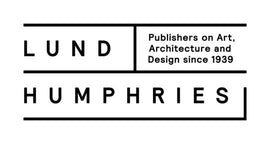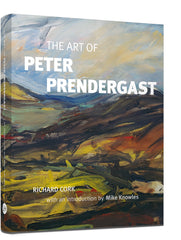Travels in the Backlist : Lund Humphries and Wales - by Nigel Farrow
To start just two miles inside Wales, I am walking in the Vale of Ewyas looking for the landscapes that feature in David Jones’ paintings from the time when he was regular visitor to Eric Gill’s Capel-y-ffin community. In particular I am looking for Y Twympa, the mountain that forms a steep scarp on the edge of the Black Mountains and which in English bears the more prosaic if not priapic name of ‘Lord Hereford’s Knob’.

David Jones, Hill Pasture, Capel-y-ffin, 1926 pencil, watercolour and chalk 37.5 × 54.6 cm (143⁄4 × 211⁄2 in) private collection.
My interest follows my acquisition of David Jones’ Y Twympa Nant Honddu and other works by an artist that until lately has not received the recognition that he deserves. Perhaps this is a consequence of his preference for the quiet media of watercolour painting and wood engraving as compared to big, colourful, attention-grabbing oils. Or in a secular age, perhaps it is Jones’ turn towards historical myths and religious symbolism following his front line experience as a Royal Welch Fusilier in the First World War. But renewed interest in the visual art has been stimulated by Ariane Bankes and Paul Hills’ The Art of David Jones: Vision and Memory which accompanied the Pallant House exhibition in 2015. The following year the BBC broadcast the Welsh National Opera’s production of an opera based on In Parenthesis, an epic poem that on publication in 1937 was rightly hailed as a work of genius by people who should know: T S Eliot, W B Yeats and W H Auden.
Kyffin Williams used to tell a possibly apocryphal story about David Jones, his fellow Welshman and fellow former Royal Welch Fusilier (Williams served in the regiment in the Second World War). The story was that Jones was in love with a beautiful woman from South Wales but in the end she decided to marry a quarry owner. In order to ease his despair on the day of the wedding, friends invited Jones to spend the day at their house. He was desolate but agreed to watch their new and still rare acquisition - a television set. He had never seen one before. It was showing the Lone Ranger. The artist was captivated and soon forgot the beautiful woman. Message: the dreamy Celtic world of myth and fantasy is no competition for the entertaining satisfactions of popular culture.
The thick impasto style of Kyffin Williams’ paintings could not be more different from the subtle transparencies of Jones’ watercolours: layers of paint applied with a palette knife to sculpt the mass of the great mountains of the Ogden Valley - Snowdon, Glyder Fach, Glyder Fawr and Tryfan. But perhaps the inspiration comes from the same Celtic origins. ‘It is in Wales that I can paint with the greatest freedom’ Williams said. ‘I found the mood that touches the seam of melancholy that is in most Welshmen, a melancholy that derives from the dark hills, the heavy clouds and the enveloping sea mists.’

David Jones, Melting Snow, 1925 Watercolour 24.7 × 32.4 cm (93⁄4 × 123⁄4 in) private collection.
Lund Humphries has published two books on Kyffin Williams. During the preparation of the first book, which combined paintings with Nicholas Sinclair’s photographs of the same locations, I visited the artist at the house on Anglesey where he had lived for the previous 30 years. It was almost under the Britannia Bridge and not far from the railway station which carries the town’s name in its elongated version: Llanfairpwll-gwyngyllgogerychwyrndrob-wllllantysiliogogogoch (at 58 characters the longest place name in Britain and second longest in Europe). The second book, Rian Evans’ Kyffin Williams: The Light and the Dark, also uses Nicholas Sinclair's photography and was published in the centenary year of the artist’s birth. The high quality reproductions of the paintings in the 150 colour illustrations do justice to the impact of the artist’s impasto technique. Kyffin Williams was knighted in 1999, the first Welsh painter to be honoured in this way.

Kyffin Williams, Spring in the Lledr Valley, 1994, Oil on canvas, 51 × 76 cm (20 × 30 in) private collection.
Peter Prendergast was a rugby-playing son of a coal miner who - like those great Welsh men of the theatre, Emlyn Williams and Richard Burton - was set on a path to high achievement by an inspirational teacher. Prendergast studied at the Slade School in the mid 1960s where one of his tutors was Frank Auerbach. The heavy black outlining of otherwise colourful forms in his paintings is perhaps an echo of this tuition. Soon after graduation and marriage, the artist moved back to Wales and lived in and around Bethesda for the rest if his life. The nearby 1200 foot deep Penrhyn Quarry, which was the largest slate quarry in the world in the nineteenth century, became a regular subject of the artist’s work. Richard Cork’s The Art of Peter Prendergast provides a well illustrated survey of landscapes and seascapes that make Wales such a special part of the United Kingdom.
John Hoole’s James Dixon Innes was a book published by Lund Humphries for the centenary of the Welsh artist’s death. As a great fan of the paintings of this tragically short lived artist, I was happy to lend several works to the exhibition held in the centenary year (2014) at the National Museum of Wales. Innes was a member of the Camden Town Group although fauviste gives a better idea of his paintings of Arenig and Lake Bala in Wales and of Collioure and the Pyrenees in France. He was a lover of Euphemia Lamb, the bohemian wife of the artist Henry Lamb, and Innes reputedly buried a silver casket of their love letters and/or a lock of her hair on the summit of Arenig Fawr. He died of tuberculosis at the age of 27.

Kyffin Williams, Farm, Deiniolen, 2001, Ink and wash on paper, 30.5 × 40.6 cm (12 × 16 in) private collection.
Two artists in the Lund Humphries list with strong Welsh connections but who are not Welsh are John Piper and Eric Gill. Helped by his Welsh wife Myfanwy Evans, Piper extensively documented and romanticised in paintings and prints the castles, churches, rivers and mountains of Wales, especially those in Pembrokeshire and Snowdonia. Orde Levinson’s definitive catalogue raisonne of the prints, The Prints of John Piper 1923-91: Quality and Experiment is an essential reference work for the many admirers and collectors of his work. Eric Gill has already been mentioned in connection with David Jones and the relatively short period that his Roman Catholic community of artists - the Guild of St Joseph and St Dominic - lived in part of a former monastery at Capel-y-ffin. It was during this time that Gill designed the Perpetua and Gill Sans typefaces. Mark Ovenden’s Johnston and Gill: Very British Types tells the story and illustrates the work of the two designers that gave birth to two of the most popular type faces.
Gwyn Lloyd Jones is the Welsh author of Travels with Frank Lloyd Wright in which he retraces Lloyd Wright's extensive international travels in Japan, Russia, Europe and the Middle East. Beautifully illustrated with Lloyd Wright’s own sketches and photographs, as well as historical photographs of his original journeys and designs, this book offers an original and contemporary view of the ambitions and lasting legacy of the first ‘global architect’. Frank Lloyd Wright himself had Welsh antecedents: his mother, Anna Lloyd Jones, was from a large family that had emigrated from Wales to the USA, settling in Spring Green in Wisconsin. The first book that Lund Humphries published was based on a series of four lectures given at the RIBA by Frank Lloyd Wright in 1939: An Organic Architecture: The Architecture of Democracy. A new edition with an introductory essay by Andrew Saint was published by Lund Humphries in 2017 to mark the 150th anniversary of the architect’s birth.
Caldey Abbey, Pembrokeshire, Wales, image taken from Arts & Crafts Churches, 2020.
And looking ahead for Welsh additions to the Lund Humphries list, in September Alec Hamilton’s Arts & Crafts Churches is published. This substantial and copiously illustrated survey discusses 200 churches built between 1884 and 1918 and lists a further 350 churches that reflect Arts and Crafts ideas and aesthetics. There is a section and local gazetteer on the Welsh churches. This is the author’s rather melancholy - that word again - conclusion to the Welsh section:
The abiding sense now, and especially in South Wales, is of buildings closed, abandoned, ruined, ignored. Partly there were simply too many of them – too many denominations, and, at the coast, sometimes doubled up to cater for both Welsh-speaking locals and English-speaking visitors. Partly it is simply a matter of economics – Wales has experienced steep industrial decline. Partly it is cultural: the turning away of Wales from chapel-going has been sharp – from the peak of the Great Revival of 1904–5, when attendances soared, followed by a rapid decline by the 1930s, until today all denominations are in retreat amounting to a rout. The Church in Wales is equally embattled. Congregations have simply walked away.
Look now, before it is all too late.
See the books mentioned in this piece by clicking on the titles or book covers.










